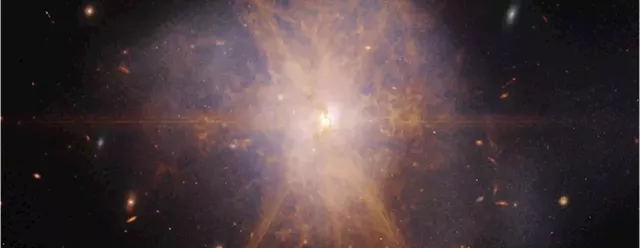This infographic illustrates the spectrum of electromagnetic energy, specifically highlighting the portions detected by NASA’s Hubble, Spitzer, and Webb space telescopes. Credit: NASA and J. Olmsted [STScI].
“Shining like a brilliant beacon amidst a sea of galaxies, Arp 220 lights up the night sky in this view from NASA’s James Webb Space Telescope.” Image credit: NASA, ESA, CSA, STScI | Processing: Alyssa Pagan Arp 220’s two spiral galaxies began colliding about 700 million years ago. The collision precipitated an “enormous burst of star formation.” Within a dusty region about 5,000 light-years across — about five percent of the Milky Way’s diameter — there are roughly 200 colossal star clusters. The amount of gas in this relatively tiny region of Arp 220 is equivalent to the gas in the entire Milky Way galaxy.
“On the outskirts of this merger, Webb reveals faint tidal tails, or material drawn off the galaxies by gravity, represented in blue — evidence of the galactic dance that is occurring. Organic material represented in reddish-orange appears in streams and filaments across Arp 220,” explains the Webb team., Webb’s image shows significantly more detail of the star-forming gas and dust surrounding the primary galactic collision.
Belgique Dernières Nouvelles, Belgique Actualités
Similar News:Vous pouvez également lire des articles d'actualité similaires à celui-ci que nous avons collectés auprès d'autres sources d'information.
 Webb captures the spectacular galactic merger Arp 220Shining like a brilliant beacon amidst a sea of galaxies, Arp 220 lights up the night sky in this view from NASA's James Webb Space Telescope. Actually two spiral galaxies in the process of merging, Arp 220 glows brightest in infrared light, making it an ideal target for Webb. It is an ultra-luminous infrared galaxy (ULIRG) with a luminosity of more than a trillion suns. In comparison, our Milky Way galaxy has a much more modest luminosity of about ten billion suns.
Webb captures the spectacular galactic merger Arp 220Shining like a brilliant beacon amidst a sea of galaxies, Arp 220 lights up the night sky in this view from NASA's James Webb Space Telescope. Actually two spiral galaxies in the process of merging, Arp 220 glows brightest in infrared light, making it an ideal target for Webb. It is an ultra-luminous infrared galaxy (ULIRG) with a luminosity of more than a trillion suns. In comparison, our Milky Way galaxy has a much more modest luminosity of about ten billion suns.
La source: physorg_com - 🏆 388. / 55 Lire la suite »
